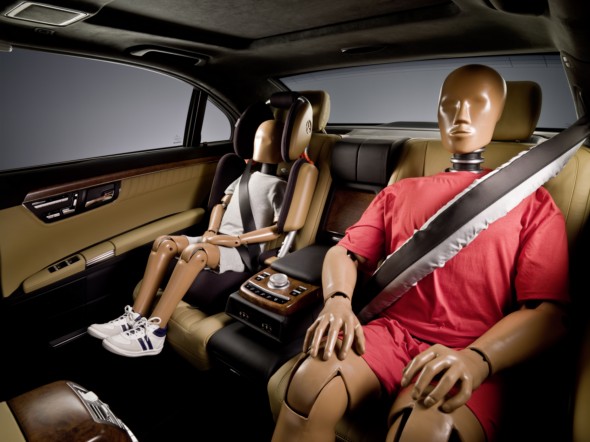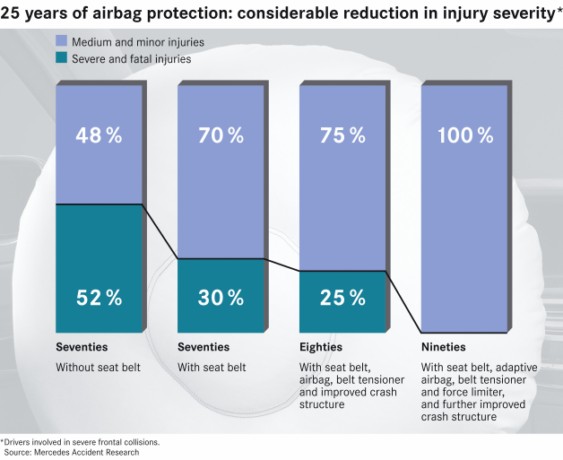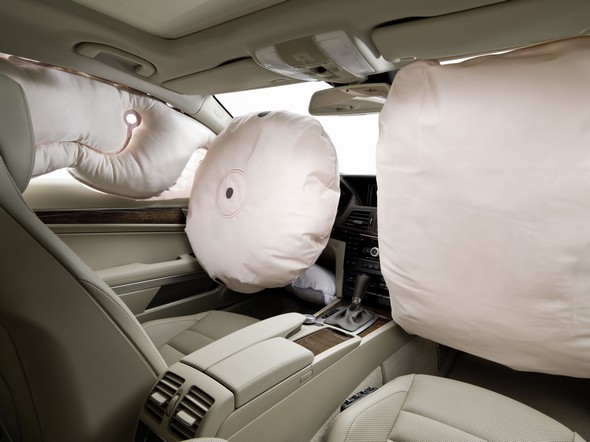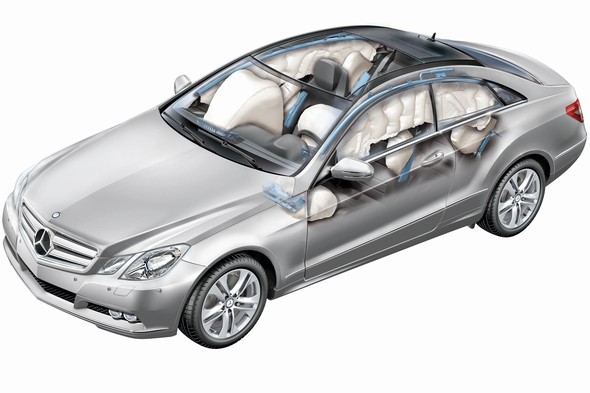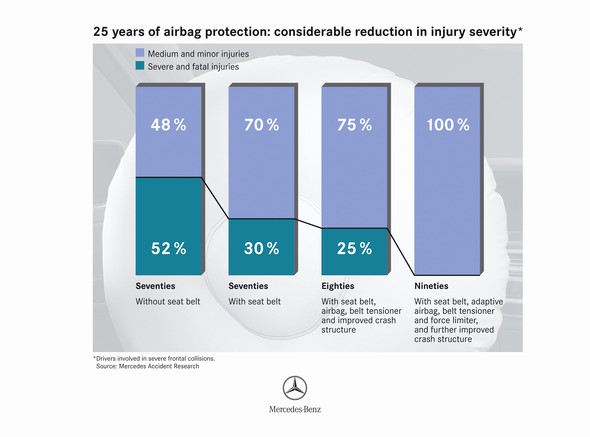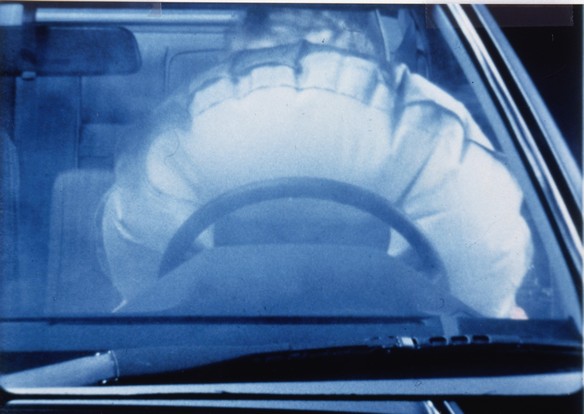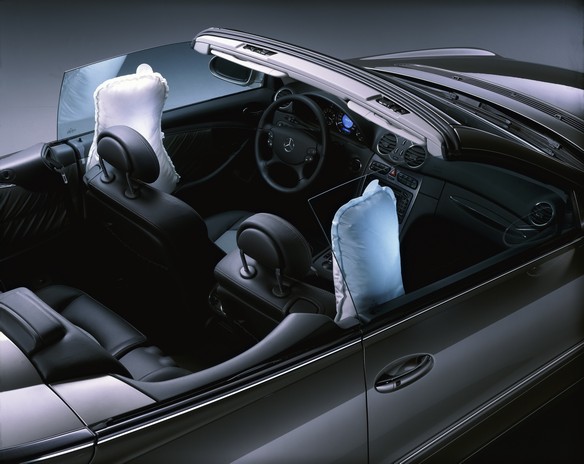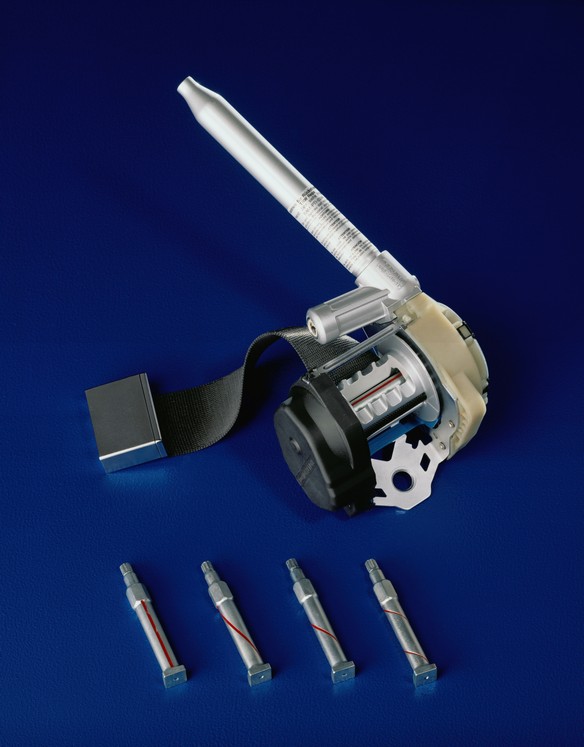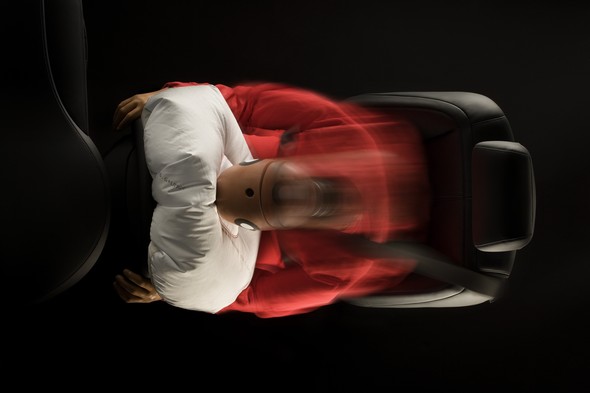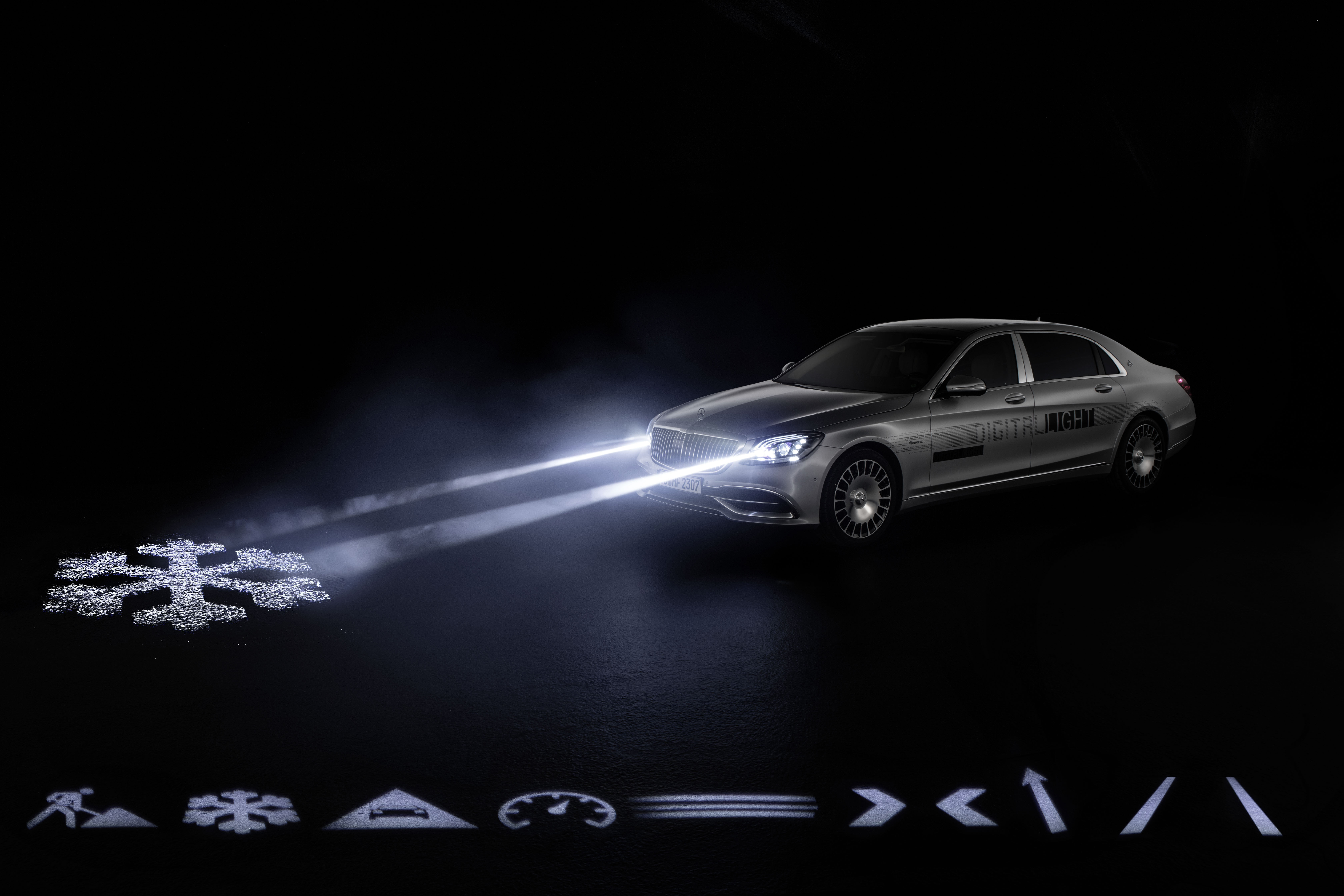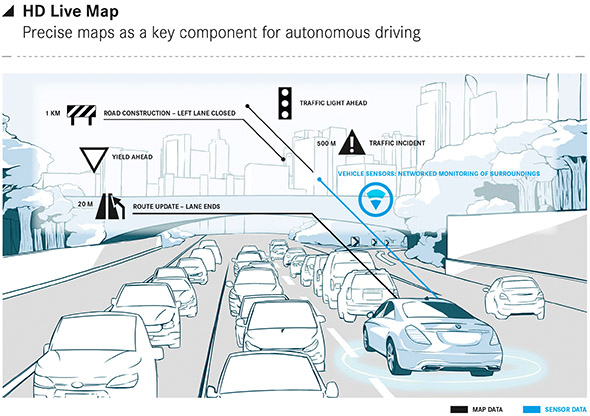Airbag, Belt tensioner and BeltBags
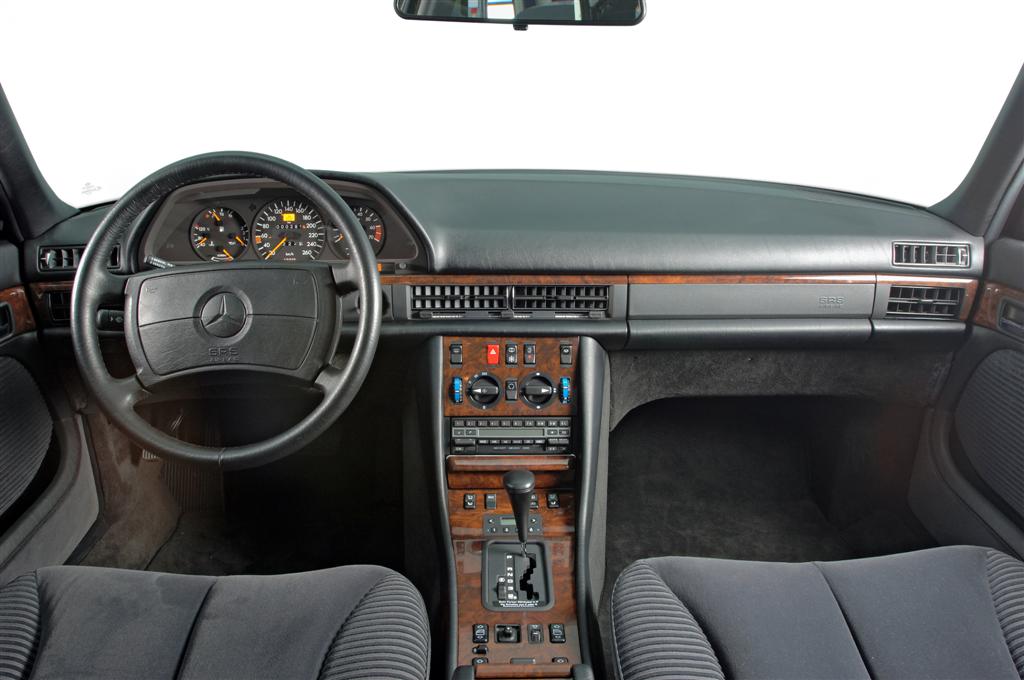
Airbag and belt tensioner world premiere in 1981 The 1981 Mercedes-Benz S-Class, the worlds first car with airbag and belt tensioner

Rocket technology for passive safety Initially an option, today a permanent integrated safety feature
In 1981 the W 126 series Mercedes-Benz S-Class attracted a great deal of attention at the Geneva Motor Show with a new item of optional equipment: the airbag and belt tensioner two passive safety innovations were celebrating their world premiere in the flagship Mercedes model.
The combination of a driver airbag and a front passenger belt tensioner was initially only available for the 126 series from July 1981, as an optional extra costing 1,525.50 DM (equivalent to around 780 euros) for the sedan and coupe.
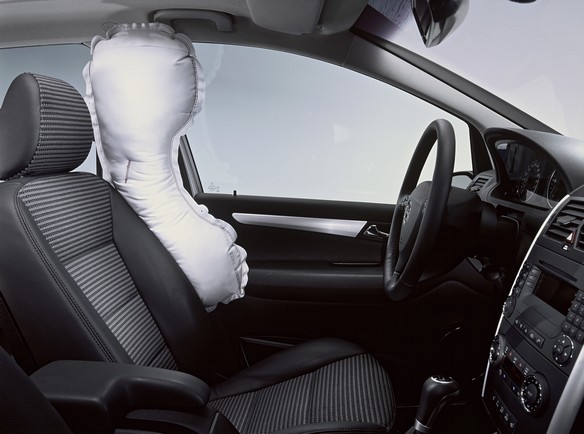
During the first year no less than 2,636 S-Class buyers opted for this new safety feature, ushering in the triumph of the airbag. More than twelve million Mercedes-Benz cars were equipped with airbags in the first 25 years of this new technology, with other brands following suit.
An optional extra for the driver of 1981 has developed into a restraint system which now protects vehicle occupants with a system of airbags, belt tensioners and belt force limiters during an accident.
A protective air cushion for car drivers
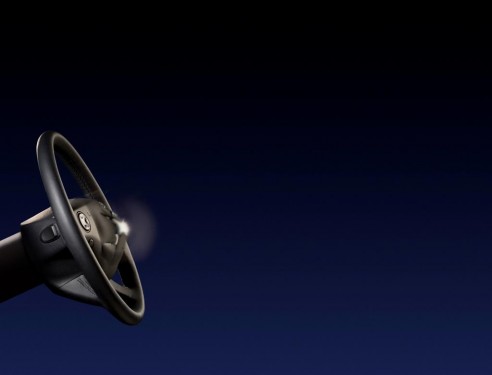

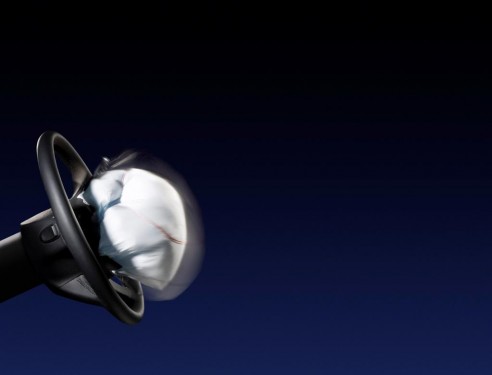
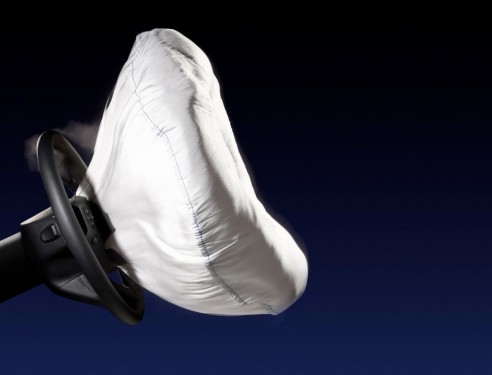
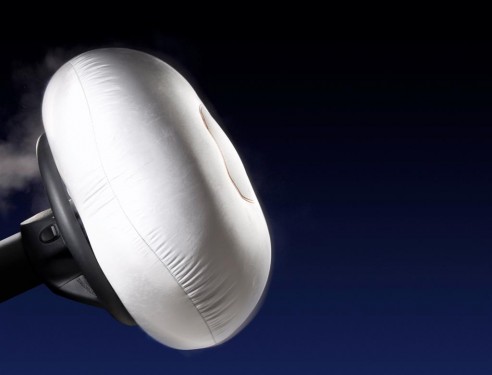
The first ideas for an air cushion which would protect drivers from impacting on the steering wheel during a collision were already aired in the 1950s. At the time it was not however possible to translate this idea into reality with the mechanical sensors and control systems available.
The idea of the airbag was given a new impetus when the United States announced plans to prescribe automatic occupant protection systems for passenger cars in 1969, and in 1973 the driver airbag was even to become compulsory for new vehicles.
The solutions presented came in for a great deal of criticism, however, and the introduction date was repeatedly postponed. Most of these projects eventually ended with no concrete result.
These developments were paralleled by continuous efforts on the part of Mercedes-Benz researchers. Work on a practical airbag already commenced in Stuttgart in 1967.
The researchers and developers had numerous hurdles to overcome in the first few years. The sensor system had to be newly developed, as did the gas generation technology and the woven material for the airbag itself.
The first tests relied on compressed air and Freon to inflate the airbag. But the best technical solution proved to be a fabric bag which could be inflated within milliseconds by a pyrotechnical charge during an accident, gently cushioning the driver. The developers adopted the sodium azide explosive charge from rocket technology.
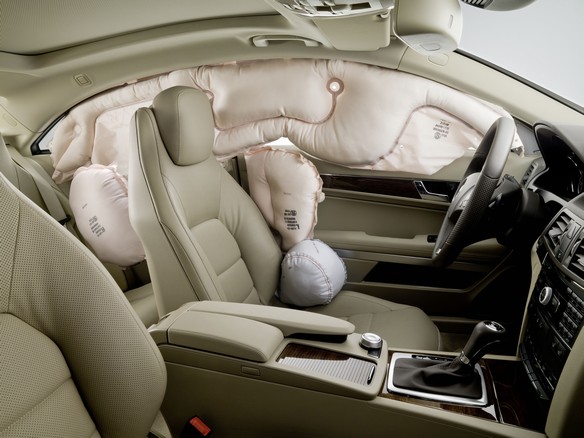
In 1971 Mercedes-Benz was granted patent number DE 2152902 C2 for the airbag. Many details of this new restraint system needed to be improved and tested before it was ready for series production.
The airbag proved its reliability during more than 250 impact tests using complete vehicles, more than 2,500 sledge impact tests and thousands of tests on individual components.
At the same time 600 vehicles entered long-term trials in on-road and off-road operations to en-sure that the airbag would not be activated during normal driving.
The evolution of the air cushion in the dashpot
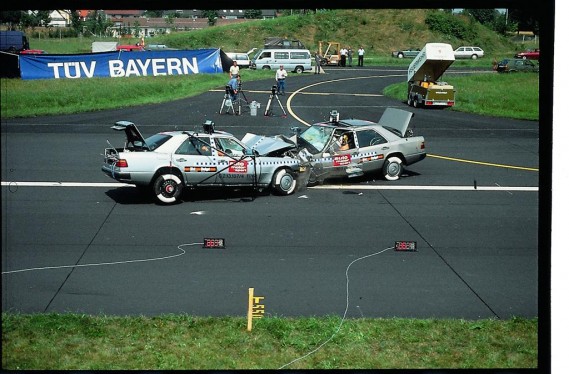
The airbag presented for the S-Class in Geneva in 1981 was still rather voluminous; therefore the dashpot of the S-Class equipped with an airbag was larger than the standard steering wheel boss.
And when the first front passenger airbag was presented at the International Motor Show (IAA) in Frankfurt in 1987, the system still occupied the entire glove compartment.
Airbag modules became increasingly smaller, however. This was made possible by continuous technical development, and also led to the creation of sidebags which would protect vehicle occupants from injury in lateral impacts.
Mercedes-Benz was already able to present a side airbag as a study in 1993, and in 1995 the side airbag became available as an optional extra for the E-Class.
In 1998 the windowbag supplemented the comprehensive protection system of the E-Class, and in 2001 Mercedes-Benz presented the head-thorax side airbag for convertibles and roadsters.
In 1992 the driver airbag became standard equipment in all Mercedes-Benz models, and in 1994 the front passenger airbag joined the list of standard safety features.

In the W 221 series S-Class, adaptive airbags are part of the safety philosophy known as PRO-SAFE. The airbags are activated in two stages, depending on accident severity and the personal data of the vehicle occupants.
Future airbag generations will be able to adapt even better to the individual occupants.
As a next technical step Mercedes-Benz developers are testing the integration of airbags into the preventive protection system PRE-SAFE.
In this case the airbags are not activated only when a collision occurs, but slightly in advance so that the occupants are supported and held in place when the impact takes place.
From the pyrotechnical belt tensioner to PRE-SAFE The belt tensioner presented in conjunction with the airbag also became a permanent passive safety feature, having been introduced in Geneva in 1981.
In an accident this support system uses a pyrotechnical charge to tension the inertia-reel seat belt worn by the front passenger within a few milliseconds.
In this way the safety technology in the W 126-series S-Class reliably fixed the front passenger in place, even if the seat belt had initially been fastened too loosely.
From 1984 all Mercedes-Benz models were equipped with front seat belt tensioners as standard.
In 1995 the belt tensioners in all models were combined with belt force limiters to adapt the action of the restraint system to individual requirements.
In 2002 the pyrotechnical belt tensioner was supplemented with an electronic belt tensioner on the introduction of the preventive occupant protection system PRE-SAFE.
This tensions the seat belts when PRE-SAFE detects a critical situation and prepares the vehicle for a potential impact. In contrast to the pyrotechnical belt tensioner the electronic system is reversible: the belt is loosened again if no impact occurs.
Airbag and seat belt as an entity
The airbag is intended as a complement to the seat belt, by no means as a replacement. This was already clear to the developers at Mercedes-Benz when they began their research for the airbag in 1967.
It is only the joint effect of the belt and airbag that provides the best possible protection against serious injury in an accident.
Since the 1981 debut of this safety technology in the S-Class, airbags combined with seat belts have literally saved thousands of human lives.
Mercedes-Benz has continued to improve its integrated safety systems with numerous innovations. In todays Mercedes cars the airbags and seat belts combine with the belt tensioners and belt force limiters to create a complex restraint system for fully integrated safety.
In 1992, in order to demonstrate the operational reliability of the restraint system even years after first delivery, Mercedes-Benz used the occasion of the one millionth airbag to be installed in one of its vehicles to conduct a crash test with a Mercedes-Benz 500 SEL produced in 1981 at the crash-testing center in Sindelfingen. The airbag deployed exactly as it was designed to do.
The service intervals recommended to ensure perfect operation are normally shorter, however.
Windowbags
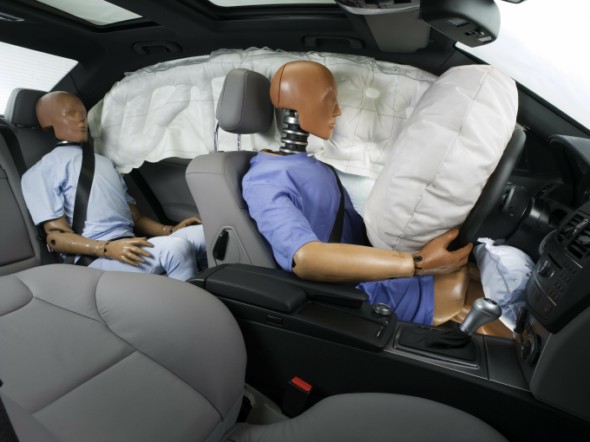
The standard specification windowbags e.g. in the C-class (W203) sports coupé each comprise four chambers with a total volume of around 25 litres, in the S-Class W220 they consist of nine chambers with a total volume of approximately 12 litres per bag.
In the event of a crash, the air cushion – in case of the W203 sports coupé 1400 millimeters long, in the S-Class W220 2000 millimeters long – inflates within a mere 25 milliseconds to form a curtain in the interior from the front to the rear roof pillar.
This provides a large flat protective surface for the heads of both the front and rear-seat passengers, regardless of passenger stature and seat position.
Under normal conditions, the windowbags are concealed behind the interior trim (roof frame, A-pillars and C-pillars). In the event of an accident, they force this trim inwards as they deploy.
The windowbags are also activated, together with the belt tensioners, if the rollover sensor detects a rollover of a certain type. The C-pillars also house the gas generators for the windowbags.
Adaptive Front Airbags

With two-stage gas generators: The front airbags inflate according to accident severity.
Beltbags
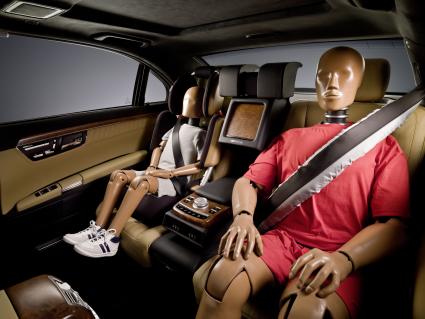
An Airbag for Seat Belts
The Beltbag, one of the highlights from the ESF 2009 Experimental Safety Vehicle, is due to go into production in a luxury-class model from Mercedes-Benz.
The inflatable seat-belt strap is able to reduce the risk of injury to passengers in the rear in a head-on collision by lessening the strain placed on the ribcage.
Should the crash sensors detect a severe frontal impact, the airbag control unit will trigger deployment and inflation of the Beltbag. A gas generator then inflates the multi-layered belt strap with Velcro seams to nearly three times its normal width.
The resulting larger surface area is able to better distribute the force acting on the seat occupant, thereby reducing the risk of injury.
The Beltbag can be used in exactly the same way as a conventional seat belt. The belt strap’s design is different from that of the standard belt though, and received top marks in practical trials for being extremely comfortable to wear and for its extra-soft belt strap edge.

“Mercedes-Benz is pursuing its safety initiative in the rear of vehicles with the Beltbag,” comments Rodolfo Schöneburg, Head of Passive Safety and Vehicle Functions at Mercedes-Benz Cars. “After all, the excellent standard of safety offered by Mercedes-Benz doesn’t just apply to all model series, but to all seats, too.”
Just like the active seat-belt buckle recently presented by Mercedes-Benz that is likewise earmarked for inclusion in a luxury model, the Beltbag was developed with a particular view toward new markets. There, the occupancy rate in the rear is as much as 30 percent, making it much higher than in Europe. By introducing the Beltbag,
Mercedes-Benz is further expanding the safety system for passengers in the rear – in contrast to many other manufacturers, seat belts in the second row of Mercedes-Benz models already come equipped with belt tensioners and belt force limiters.
It is not planned to introduce the Beltbag for the front occupants, as airbags are already included in the front on all models as a supplementary restraint system.
Because dummy measurement technology is not capable of quantifying the benefits resulting from a wider belt strap, such as the lower force exerted on occupants, the safety experts at Mercedes have also been working intensely with virtual human models, as such computer-generated models make it possible to obtain detailed findings on the biomechanical strain during a collision.
Sidebag
The standard sidebags in the front are located in the doors above the armrests. Sidebags for the rear are available as an option. The asymmetrically designed air cushions have a volume of 13 liters each with the C-Class (W203) .
In the case of a collision from the side, the sidebag rips open a seam in the door or side trim and inflates between the occupant and the door to prevent the occupant from being knocked against the door or side trim.
This has a dual effect: as well as clearly reducing the loads exerted on the chest of the occupant sitting on the same side as the crash, the sidebag also limits upper body movement during the collision.
Belt Tensioners
In a more severe frontal impact, the belt tensioners instantly pull the driver’s and front passenger’s belts more tightly around their body.
This increases the effectiveness of the seatbelts, since the forward displacement of the upper part of the body is reduced.
Belt Force Limiters
Mercedes-Benz has equipped e.g. the C-class (W203) sports coupé with belt tensioners for all seats or e.g the S-Class W220 on the front seats and outer rear seats as standard, which combine with the belt force limiters and airbags to significantly reduce the strain exerted on the chest region of passengers in the event of an accident.
The belt force limiter is located inside the inertia reel and comprises a torsion bar, which turns slowly when a force exceeding a pre-determined level acts on the belt strap, thereby carefully reducing the locking effect of the inertia reel.
Due to the force limiter, the inertia reel seat belt slackens again after exceeding a certain force threshold which reduces the degree of force exerted by the seat belts on the occupants.
Automatic Child Seat Recognition
The front passenger seat e.g. of the Mercedes-Benz C-class (W203) sports coupé is equipped as standard with technology which automatically recognizes special rearwards-facing child seats fitted with a transponder system.
The electronic unit transmits a coded inquiry signal via two antennae in the seat upholstery, which receivers (transponders) in the base of the rearwards-facing child seat decode and then reply to with a response code.
This code is relayed from the seat antennae to the airbag electronics which thus ‘recognize’ that such a child seat is installed. If this is the case, the microcomputer automatically prevents deployment of the front passenger airbag.
The “Airbag Off” indicator lamp in the centre console illuminates to confirm that the antennae and transponder have exchanged signals correctly.

Windowbag
The standard windowbags in the CL-Class each consist of nine chambers with a total volume of approx. twelve litres.
During a lateral impact exceeding a certain severity, the approx. 2000 millimetre long air cushion extends from the front to the rear roof pillar like a curtain within approx. 25 milliseconds, providing effective head protection on the impact side from which both the front and rear occupants benefit – whatever their physical size or seating position.
When not in use the windowbags are concealed behind the interior lining on the roof frame and the A and C-pillars. In the event of an accident these are pushed inwards so that the windowbags are able to deploy.
In addition both windowbags are activated together with the belt tensioners if the roll-over sensor detects the impending danger of a specific type of roll-over.
For model year 2003 Mercedes-Benz is supplementing the efficient occupant protection systems in the CL-Class with new developments which reflect the latest accident research findings and enable the airbags, sidebags, windowbags and belt tensioners to function as the situation requires.
With its adaptive front passenger airbag, which inflates in two stages depending on the severity of an accident, the Mercedes CL-Class Coupé has already been the trendsetter for situation-related occupant protection in its vehicle class since 1999.
The engineers in Sindelfingen have now optimised this technology with newly developed up-front sensors located at the front end.
Owing to their forward position these are able to assess the severity of an impact even sooner than the crash sensor on the transmission tunnel.
As a result the airbag control unit can shorten the time lapse between the impact and activation of the belt tensioners, and control the two-stage front passenger airbag even more precisely.
During a minor frontal collision only one chamber of the two-stage airbag gas generator is triggered, inflating the airbag to a lower internal pressure.
If the control unit recognises a severe frontal collision by virtue of the up-front sensors, it also activates the second chamber of the gas generator approx. five to fifteen milliseconds later.
This inflates the airbag to a higher pressure and provides a level of protection suited to the severity of the accident.
Measuring membrane in the front passenger seat cushion
In addition to accident severity the airbag computer also takes the bodyweight of the front passenger into account when activating the airbag on the passenger side of the instrument panel according to the situation.
A special measuring membrane in the seat cushion makes this possible. It enables the bodyweight of the front passenger to be classified into one of four categories, so that even during a less severe accident, for example, both airbag stages can be activated to give a heavy front passenger the best possible protection.
Conversely this individual weight classification could mean that in the case of a lighter front passenger, the second airbag stage would only be activated if the impact is very severe.
The new measuring membrane is a further development of the seat occupancy recognition system developed by Mercedes-Benz a few years ago.
This ensures that the airbag, belt tensioner and sidebag on the front passenger side are automatically deactivated if the front passenger seat is unoccupied. In this way the adaptive system helps to keep repair costs down following an accident.
New roll-over sensor for windowbag activation
Activation of the windowbags and belt tensioners during a roll-over is a new feature. Mercedes-Benz has equipped the CL-Class with a special sensor which recognises this type of accident and transmits its data to the control unit for the restraint systems within milliseconds.
A programme stored in the control unit memory enables the microprocessor to analyse and assess the nature of the accident.
If it establishes that the windowbags will potentially provide additional occupant protection during an impending roll-over, the large air cushions along the vehicle sides are activated within just 25 milliseconds.
For model year 2003 Mercedes-Benz is supplementing the efficient occupant protection systems in the CL-Class with new developments which reflect the latest accident research findings and enable the airbags, sidebags, windowbags and belt tensioners to function as the situation requires.
With its adaptive front passenger airbag, which inflates in two stages depending on the severity of an accident, the Mercedes CL-Class Coupé has already been the trendsetter for situation-related occupant protection in its vehicle class since 1999. The engineers in Sindelfingen have now optimised this technology with newly developed up-front sensors located at the front end.
Owing to their forward position these are able to assess the severity of an impact even sooner than the crash sensor on the transmission tunnel.
As a result the airbag control unit can shorten the time lapse between the impact and activation of the belt tensioners, and control the two-stage front passenger airbag even more precisely.
During a minor frontal collision only one chamber of the two-stage airbag gas generator is triggered, inflating the airbag to a lower internal pressure.
If the control unit recognises a severe frontal collision by virtue of the up-front sensors, it also activates the second chamber of the gas generator approx. five to fifteen milliseconds later.
This inflates the airbag to a higher pressure and provides a level of protection suited to the severity of the accident.
Airbags get breath of fresh air from Mercedes-Benz

